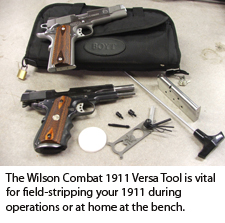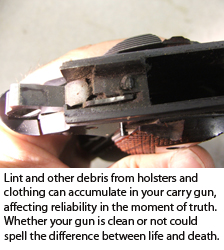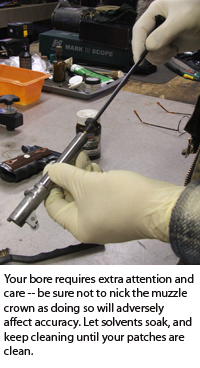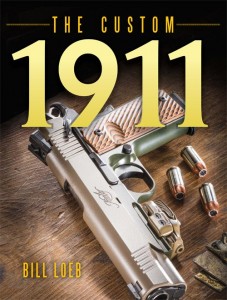 A few years ago, I was shooting a basic pistol course at Gunsite with a Sig P 220 ST. The course lasted a week, and instructors recommended that each student bring at least 1,000 rounds of ammo. Some students actually shot more (I fired about 1,100 rounds). The Sig is an extremely reliable pistol, so I figured the course provided a good chance to see how long the gun would last without cleaning before it started to malfunction.
A few years ago, I was shooting a basic pistol course at Gunsite with a Sig P 220 ST. The course lasted a week, and instructors recommended that each student bring at least 1,000 rounds of ammo. Some students actually shot more (I fired about 1,100 rounds). The Sig is an extremely reliable pistol, so I figured the course provided a good chance to see how long the gun would last without cleaning before it started to malfunction.
The test wasn’t very scientific, but about halfway through the course, I started to experience failures in extraction and the slide closing. It was nothing major — just enough to make you nervous. Actually, that was perfect, because we worked on clearing jams, and my problems provided good training. That night, a good cleaning solved all the problems.
A dirty gun will eventually start to affect reliability. Because you don’t know when you’ll need your weapon, it’s imperative to keep it cleaned and lubricated after each shooting session.
I once read that Wild Bill Hickok used to shoot the loads out of his Navy revolvers every morning, clean them and reload the guns for the day. That’s a bit paradoxical, because the only reason he had to clean the guns is because he shot them to unload them. Wild Bill believed that his equipment should be ready in case of an unexpected assault.
We must take care of our guns so they can take care of us. With modern products, that’s not a time-consuming process, and it can be done in minutes after shooting.
Break Them Down, Clean Them Up
 The first thing I do with my pistols is break them down to the manufacturer’s recommended cleaning condition. That usually means removing the slide, barrel and spring from the frame. With a single-action revolver, the cylinder comes out of the frame. Of course, that’s unnecessary with a double-action revolver. I don’t dismantle the entire frame every cleaning unless something happened to warrant it, like dropping the gun in water or sand. Don’t laugh — it happens. I like the fact that you can take the barrel out of a pistol to clean it. I think that lets me do a better job.
The first thing I do with my pistols is break them down to the manufacturer’s recommended cleaning condition. That usually means removing the slide, barrel and spring from the frame. With a single-action revolver, the cylinder comes out of the frame. Of course, that’s unnecessary with a double-action revolver. I don’t dismantle the entire frame every cleaning unless something happened to warrant it, like dropping the gun in water or sand. Don’t laugh — it happens. I like the fact that you can take the barrel out of a pistol to clean it. I think that lets me do a better job.
A gun bore is extremely sensitive to mistreatment. I like to clean every bore with the same care as I would a sniper rifle. Many people use bore snakes nowadays, and those do a good job cleaning bores. I’m a bit old-fashioned and like to scrub out the bore with a brush and patches. Also, I shoot lead bullets in my .45 and 10 mm, and even though lead is really hard these days, it usually leaves some fouling you must remove. In my cowboy guns, through which I frequently shoot lead, there comes a point when accuracy goes out the window because of lead build-up. Therefore, those guns get a quality scrub after every shooting session.
My semiautos shoot copper and lead, as I shoot defensive ammo. However, I don’t depend on the copper to push out all the lead because I don’t believe it does. Besides, copper also leaves deposits that must be removed.
I give the barrel a good soaking with Shooter’s Choice, which I have been using for many years. The company makes solvents for lead and copper. Hoppe’s has been around since I can remember, and I still use No. 9 and other products. I like Bench Rest 9 copper solvent when I use jacketed bullets.
Regardless of which solvent I use, I’ll wet a patch, spread it out in the barrel and then set the barrel aside to soak. Then, I work on the frame of a pistol or cylinder of a single-action. While that’s soaking, I spread solvent on other parts that need to soak. I believe solvent works better the longer it’s on fouling.
For many years, I’ve worn surgical gloves when using solvents. These substances are notorious for permeating skin, and as much as I use the stuff, I think gloves are a wise precaution. A box of 100 gloves costs about $6 bucks and lasts a long time. The ones without powder and are a little thicker work great. They are really useful around the shop to keep junk off your hands.
 I use brass brushes exclusively, even on my pistols. If fouling won’t come off with brass, it won’t come off with stainless steel. The trick is to be persistent and keep scrubbing. Brass wears easier on the bore, too. I also use brass toothbrush-type brushes on the frame and around the cylinder and forcing cone. Nylon is OK, too, but hammered-on fouling around the forcing cone of a single-action will come off faster with a brass bristle brush.
I use brass brushes exclusively, even on my pistols. If fouling won’t come off with brass, it won’t come off with stainless steel. The trick is to be persistent and keep scrubbing. Brass wears easier on the bore, too. I also use brass toothbrush-type brushes on the frame and around the cylinder and forcing cone. Nylon is OK, too, but hammered-on fouling around the forcing cone of a single-action will come off faster with a brass bristle brush.
After a good scrubbing with brass, I send another wet patch down the barrel and around the frame and other areas and then brush it again. Usually, I make 10 to 15 strokes in the barrel and make sure the other spots are visibly clean. Then, I run a few dry patches down the barrel and wipe off the external spots. I look down the barrel with a light. Usually, you can see lead deposits along the edge of the rifling. Copper deposits will show up as green stains on the patches. When the green disappears, the copper is pretty much cleaned up. I repeat these steps the patch comes out of the barrel clean.
After I’m happy with the barrel and other spots, I run some JB Non-Embedding Bore Cleaning Compound down the barrel. I get it from Brownell’s, and it’s amazing stuff. Even if my patches are coming out of the bore clean, I can run some of this through the barrel on a patch, and the patch comes out black.
When selecting a cleaning rod, it’s wise to use a material that is softer than steel. Many are made of aluminum or polymers. The idea is to have something that will yield to the steel of the bore if you accidentally bump the crown. The rod should be relatively stiff so it doesn’t bend and rub the inside of the bore. Brownell’s catalog has too many bore and chamber guides to list here. Most are very inexpensive and should be used during every cleaning job.
Rifles should be cleaned from the chamber side, if possible, and a chamber guide will help you avoid damage to the throat. If you’re cleaning a lever gun or revolver you must enter through the muzzle, a cleaning rod with a guide will keep the rod lined up and protect the crown.
Make sure your other disassembly tools don’t damage gun parts. A good hollow-ground screwdriver set is a must. These sets are so inexpensive nowadays that every gun owner should have one.
The Versa Tool by Wilson Combat is one tool I always keep in my 1911 bag. It’s a pocket-sized tool kit with everything to dismantle a 1911. It’s great for quick repairs on the line or quick cleanings during a hunting trip or other mission. As a 1911 fan, I’m never without one.
Down to Parts
When it’s time to break the gun down to a pile of parts, I still clean the aforementioned parts the same way. I use solvent to clean all the small trigger parts and springs. If you don’t like the smell of solvents, you can also remove dried oil and crud with Simple Green. It does a good job but removes all the oil, so the metal will have to be relubed to avoid rust.
 If you’re not familiar with the full disassembly of your pistol, take it to a good gunsmith for this cleaning. Some guns will go back together several ways, but only one will let it function.
If you’re not familiar with the full disassembly of your pistol, take it to a good gunsmith for this cleaning. Some guns will go back together several ways, but only one will let it function.
When I take an action down completely, I clean each part and lightly oil it with Break Free oil. I rub the oil into each part so it gets into the metal, keeping it slippery and protected. I use Brownell’s Moly Paste on the sear and trigger surfaces because it’s a dry lubricant. It will not collect grime and dust like oil does, and it works its way into the metal and decreases wear to make the trigger feel better.
After I reassemble the gun, I rub a rag impregnated with Break Free over the outer surfaces. This leaves a very light protective coat on the finish of the gun but doesn’t feel oily. This is important to protect the surface of a carry gun, especially one with a blue finish. Sweat from carrying in warm climates will attack a finish like saltwater.
If you plan to store the gun, place it in a case that will protect it. Boyt makes Tactical cases that protect against corrosion. The copper-infused lining was developed to protect vehicles being shipped overseas against salty ocean winds. I have a pistol case that holds my Springfields, six magazines, a Versa Tool and some cleaning supplies. Also, I can carry it in a bigger Tactical Bag. For a SWAT operator, this is a great case for call-outs.
During warmer months, I shoot at least once a week and clean my carry pistols relatively often. Remember to keep an eye on a carry pistol you don’t shoot often. During winter, lint and dust from clothing builds up around the trigger and hammer areas. I’ve even found it in the mechanism during complete cleanings. Usually, I blow lint out with compressed air, and if I have a lot of lint, I’ll pull it down and wipe everything off. If I carry my pistol in dusty conditions in an external holster, I clean it up occasionally, even though I haven’t fired it. I was really fussy with my duty pistol and touched it up often.
There’s a faster way to clean the complex parts of a gun without tearing it apart: gun-blaster-type products. These do not replace full disassembly and cleaning, but they help you in a pinch. Hoppe’s makes one, as do Tetra and Birchwood-Casey. These have cleaning fluids in pressurized spray cans, and melt crud and blow it out of the action. When it dries, it leaves a dry action with no oil, so the action requires some lubrication. The trick is to lubricate action parts lightly, without gobbing on too much oil. Too much of even the best lubricant will attract dirt and grit and cause problems.
 You can also clean handguns with a solvent tank and compressed air. At the police firearms range, we had a huge parts washer filled with Hoppes No. 9. We field-stripped our guns after qualifying and soaked them down. We had to remove the grips from the gun, but the solvent saturated all the parts. Then, we brushed out fouling with brass bore brushes and toothbrush-type brushes. Excess solvent was then blown out with compressed air and dried off with a cloth. We lightly oiled our guns, and they were ready for duty.
You can also clean handguns with a solvent tank and compressed air. At the police firearms range, we had a huge parts washer filled with Hoppes No. 9. We field-stripped our guns after qualifying and soaked them down. We had to remove the grips from the gun, but the solvent saturated all the parts. Then, we brushed out fouling with brass bore brushes and toothbrush-type brushes. Excess solvent was then blown out with compressed air and dried off with a cloth. We lightly oiled our guns, and they were ready for duty.
A small parts washer is very inexpensive. I use a tabletop model in my shop for cleaning gun parts. These can be used in lieu of spray-can blasters. Be careful where the solvent blows, and make sure there’s adequate ventilation. If vapor odor is a problem, you can fill the parts washer with Simple Green.
Shooters often forget about magazines, but they also require frequent care. Faulty magazines cause most semiauto malfunctions. Wipe mags clean of dust, and remove fouling from the feed ramp. Most magazines can be taken apart and cleaned. It’s amazing how much dust collects inside them. Be careful not to bend the feed lips when taking them apart. Occasionally, I shoot carry ammo in the magazines and replace it with fresh rounds. That gives me practice with my carry stuff and rotates ammo on which I might have to depend.
Keep Them Running
Maintenance is the key to reliability and weapon longevity. Guns are machines that are prone to malfunction. Design has relieved many flaws, but proper maintenance will keep a defensive tool running when you need it most.
The Custom 1911
Learn how to ask the right questions when purchasing your 1911 pistol, and make an informed, intelligent decision with the wealth of information provided in The Custom 1911 by Bill Loëb. Because this ever-popular pistol has been produced by more companies than any other firearm in history, the available options may at first seem intimidating. Wade through the vast availability of the 1911 pistol, and grow in your understanding of the main differences between the abundance of custom shops.


![Best Concealed Carry Guns In 2025 [Field Tested] Wilson Combat EDC X9S 1](https://gundigest.com/wp-content/uploads/Wilson-Combat-EDC-X9S-1-324x160.jpg)


![Best 9mm Carbine: Affordable PCCs [Tested] Ruger Carbine Shooting](https://gundigest.com/wp-content/uploads/Ruger-Carbine-Shooting-100x70.jpg)
![Best AR-15: Top Options Available Today [Field Tested] Harrington and Richardson PSA XM177E2 feature](https://gundigest.com/wp-content/uploads/Harrington-and-Richardson-PSA-XM177E2-feature-100x70.jpg)
